| Marc Hesse Home Multiphase Group Research Publications Teaching Job Opportunities News Group members |
Multiphase geosystemsMelt migration & partially molten materials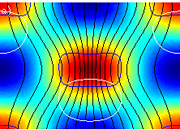 Partial melting is a fundamental process generating chemical heterogeneity in
terrestrial planets. We develop models and numerical methods that to simulate
the extraction of melt under mid-ocean ridges to address fundamental questions
about the mantle structure under ridges, the chemical evolution of crust and
mantle, the preservation of deep chemical signatures and the focusing of melt
towards the ridge.
Partial melting is a fundamental process generating chemical heterogeneity in
terrestrial planets. We develop models and numerical methods that to simulate
the extraction of melt under mid-ocean ridges to address fundamental questions
about the mantle structure under ridges, the chemical evolution of crust and
mantle, the preservation of deep chemical signatures and the focusing of melt
towards the ridge.Geological CO2 storage and natural CO2 reservoirs Geological CO2 storage is currently the only option to mitigate anthropogenic CO2
emissions from continued use of fossil fuels. Secure geologic storage of CO2 requires
an understanding of the long-term evolution of CO2 in the subsurface. We aim to quantify
the rates of the physical mechanisms that are likely to trap CO2 underground. Trapping
mechanisms are convective dissolution of CO2 into the brine and the trapping of CO2 as
immobile phases by capillary forces on the pore scale. Geological CO2 storage is currently the only option to mitigate anthropogenic CO2
emissions from continued use of fossil fuels. Secure geologic storage of CO2 requires
an understanding of the long-term evolution of CO2 in the subsurface. We aim to quantify
the rates of the physical mechanisms that are likely to trap CO2 underground. Trapping
mechanisms are convective dissolution of CO2 into the brine and the trapping of CO2 as
immobile phases by capillary forces on the pore scale. Geomechanics and inverse problems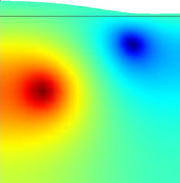 We study the effects of aquifer deformation on the pressure bulid-up in the storage formation and aim to link these models to measurements of surface deformation. Recent advances in satellite geodesy allow high resolution spatially distributed measurements of vertical displacements and promise to provide important spatial information on spatial variations in aquifer properties To assimilate surface deformation data and other hydrologic observations into the flow models we are developing gradient/adjoint-based algorithms. Fundamental processesConvection in porous media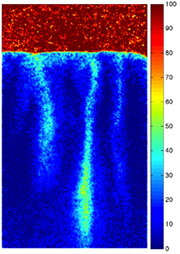
Convective motion introduced by temperature or concentration gradients is thought to be wide spread in sedimentary basins and the oceanic crust and often controls the rates of chemical and energetic exchange in geologic systems. We are interested in the determination of stability criteria for realistic hetero-geneous systems, as well as quantifying the fluxes in unstable systems. We are developing experimental systems that allow the quantification of convective fluxes in different scenarios, aim to develop scaling laws and other theories to explain the observed behavior and develop high resolution adaptive numerical methods that are benchmarked against physical data. Two-phase flow in porous media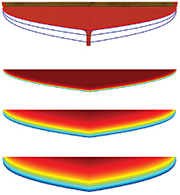 Two-phase flow is central to a large number of geological processes and environmental problems.
We are developing models for two-phase gravity currents to understand the migration of non-wetting
phases like CO2 or non-aqueous contaminants in the subsurface. We are also working on theories for
two-phase flow coupled with chemical reactions in the aqueous phase to determine the interaction
of CO2 with shallow groundwater aquifers. Accurate determination of migration velocities of
CO2
requires high resolution computations over very large areas and is currently not feasible on the
field scale. We are interested in the development of adaptive numerical simulations that resolve
the migrating CO2 plume. Two-phase flow is central to a large number of geological processes and environmental problems.
We are developing models for two-phase gravity currents to understand the migration of non-wetting
phases like CO2 or non-aqueous contaminants in the subsurface. We are also working on theories for
two-phase flow coupled with chemical reactions in the aqueous phase to determine the interaction
of CO2 with shallow groundwater aquifers. Accurate determination of migration velocities of
CO2
requires high resolution computations over very large areas and is currently not feasible on the
field scale. We are interested in the development of adaptive numerical simulations that resolve
the migrating CO2 plume. Reactive flow in porous media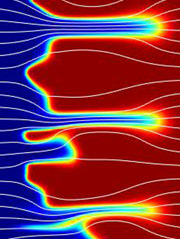 The theory of hyperbolic conservation laws provides
a unifying approach to the local equilibrium limit of reactive
flow in porous media. We study the development of chromatographic
patterns due to dissolution/precipitation, sorption, and two-phase
flow with phase equilibrium. The theory of hyperbolic conservation laws provides
a unifying approach to the local equilibrium limit of reactive
flow in porous media. We study the development of chromatographic
patterns due to dissolution/precipitation, sorption, and two-phase
flow with phase equilibrium. Most minerals are not pure but complex solid solutions and the non-ideality can have important implications for high temperature systems as divers a melt migration and geothermal energy extraction. We are extending the hyperbolic theory to include solid solution and we are developing a numerical simulator for reactive porous flow with solid solution to capture these first order effects. |
|
|